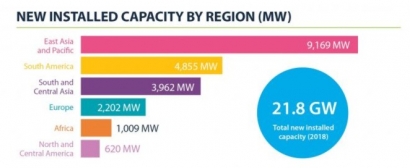
Government ministers from Canada, Indonesia, Nepal, Uganda and Uruguay contribute policy interventions to the sixth edition of the Hydropower Status Report, each emphasizing the need for investment in renewable energy, and especially hydropower, to help countries achieve sustainable development.
Electricity generation from hydropower projects achieved a record estimated 4,200 TWh in 2018, the highest ever contribution from a renewable energy source, as worldwide installed hydropower capacity climbed to 1,292 GW.
China added the most capacity with the installation of 8,540 MW, followed by Brazil, Pakistan, Turkey, Angola, Tajikistan, Ecuador, India, Norway and Canada.
Brazil has now become the second largest producer of hydroelectricity by installed capacity, reaching 104.1 GW in 2018, surpassing the United States at 102.7 GW. The world's largest hydropower producer is China with 352.3 GW of installed capacity.
The Hydropower Status Report, published by the International Hydropower Association (IHA), is an authoritative guide to key trends in hydropower development. Compiled by IHA’s team of analysts, the report presents latest capacity and generation data from more than 200 countries and territories.
The report also features policy insights from leading government ministers responsible for hydropower development:
With pumped hydropower storage capacity reaching 160.3 GW in 2018 (up 1.9 GW on 2017), the report also calls for the market framework and regulatory treatment of this clean ‘water battery’ technology to be reformed, especially in liberalized markets.
“Four years on since the Sustainable Development Goals were agreed at the United Nations in 2015, governments increasingly recognize hydropower as playing a vital role in national strategies for delivering affordable and clean electricity, managing freshwater, combating climate change and improving livelihoods,” write IHA Chief Executive Richard Taylor and IHA President Ken Adams in the foreword to the report.

